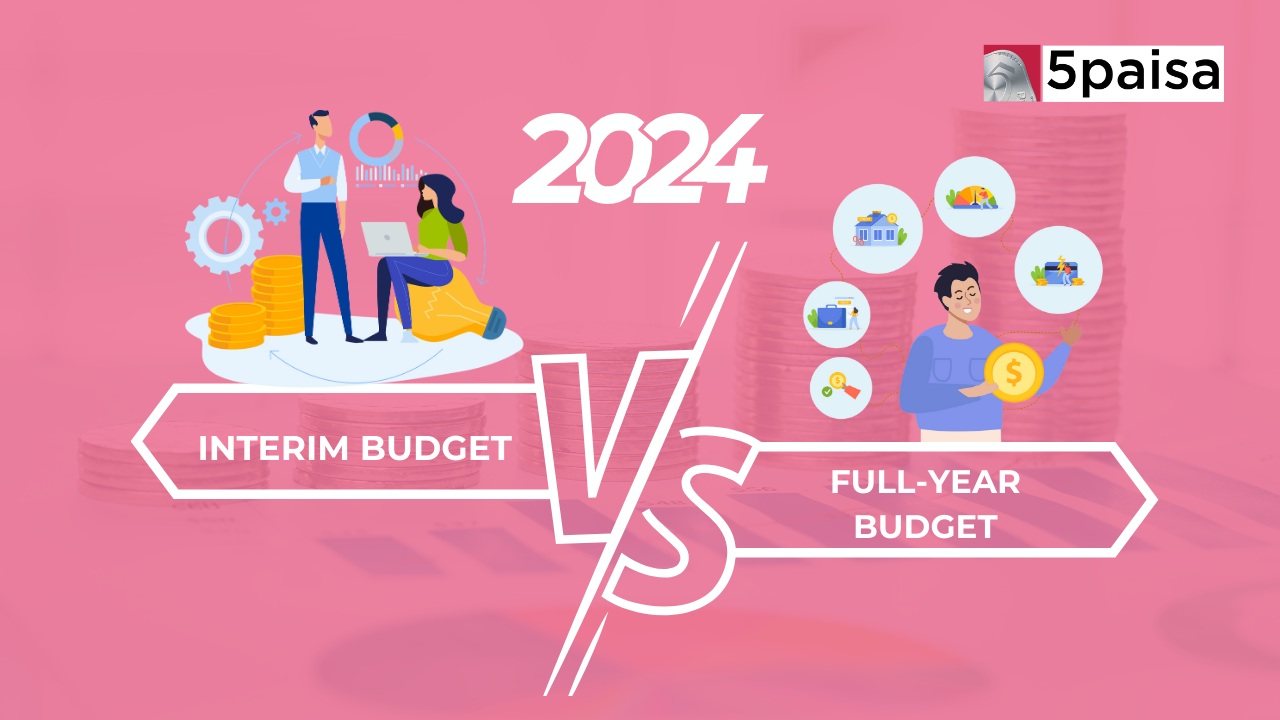Why Finance Minister Hikes STT on F&Os?
Budget 2024 Breakdown: Interim Budget vs Full-Year Budget

Last Updated: 18th July 2024 - 12:16 pm
India’s economy is currently standing out amid a global economic slowdown, with projections for its economic growth in FY24 ranging from 6.3% (as per the IMF and World Bank) to 6.5% (according to the RBI). In contrast, global growth, according to the IMF, is anticipated to decrease from 3.5% in 2022 to 3% in 2023 and further to 2.9% in 2024.
Other Side Finance Minister Nirmala Sitharaman is scheduled to announce the interim budget for 2024-25 on 1 February 2024. This interim budget precedes the upcoming general elections, and the full budget will be presented once the new government is in place.
This marks Sitharaman's sixth budget presentation, and in India's fiscal management, the terms "Interim Budget" and "Full-Year Budget" play crucial roles, each serving specific purposes and timelines in the nation's economic cycle.
Understanding the difference between an Interim Budget and a full year Budget is important in navigating India's economic landscape. Let's explore the distinction between an Interim Budget and a full-year Budget.
What is an interim budget?
An interim budget is like a short term financial plan that the government puts in place when elections are approaching or when a new government is about to take over. It's a quick arrangement to manage the government's spending needs until a new government can create a complete budget.
Key Aspects of an Interim Budget
Expenditure Allocations
An interim budget prioritizes the allocation of funds for crucial government operations, ongoing projects, and urgent requirements. Unlike a full year budget, it refrains from introducing new policies or schemes that involve financial implications.
Policy Limitations
As it's a short term arrangement, an interim budget doesn't make lasting policy changes. Instead, its main goal is to maintain stability and keep things running smoothly until a new government steps in.
Approval Process
Unlike a full year budget, an interim budget doesn't go through the usual detailed examination and discussion in Parliament. Instead, it's proposed for a "vote-on-account" to quickly get approval for essential expenses until a new government can present a complete budget.
A "Vote-on-Account" is a process where the government asks Parliament for approval to use funds needed to cover expenses for part of the year until a new government is formed.
Financial Statements
An interim budget comprehensively addresses all the expenses and income from the previous year, including anticipated expenditures in the coming months until the new government assumes office. In this transitional period current government requires the approval of Parliament to access funds from the Consolidated Fund of India, which serves as the repository for all its revenue.
Election Year Realities
Putting together a full year budget during an election year demands a lots of effort from the current government. Interim budget provides a crucial opportunity for the incoming government to step in and carefully plan the budget for the rest of the financial year.
What is a Full-Year Budget?
Full year budget is like the government's financial GPS, guiding where money comes from and where it goes. It details how the government expects to earn money like through taxes and other income sources and how it plans to spend that money on things like education, healthcare, infrastructure, and defense. It also introduces new policies and reforms to boost economic growth and social development showing the government's vision for the nation's financial well being.
Unlike the interim budget full year budget undergoes a thorough examination, discussion and approval process in both houses of Parliament. This involves debates on various aspects of the budget, allowing for detailed analysis and potential changes before it gets the final approval.
Interim Budget Vs Full-Year Budget
Interim budget provides estimates for government spending, revenue projections, fiscal deficit and financial outlook for the upcoming months. However it cannot introduce policy changes that might affect the responsibilities of the next government.
A budget 2024 is typically divided into two parts: one that looks at the income and expenses of the past year and the other that outlines anticipated expenses for the upcoming year. In the case of an interim budget the first part includes details of the previous year's income and expenses, while the second part only covers essential expenses until the upcoming election.
On the other hand, a full year budget also known as the Annual Financial Statement is a comprehensive financial plan. It includes all aspects of government spending, revenue and policy changes for the entire fiscal year. Unlike the interim budget full year budget provides a detailed roadmap for the government's financial activities over the year.
Visit - Live Union Budget 2024
- Flat ₹20 Brokerage
- Next-gen Trading
- Advance Charting
- Actionable Ideas
Trending on 5paisa
Budget Related Articles
Disclaimer: Investment in securities market are subject to market risks, read all the related documents carefully before investing. For detailed disclaimer please Click here.
 5paisa Research Team
5paisa Research Team
 Sachin Gupta
Sachin Gupta




